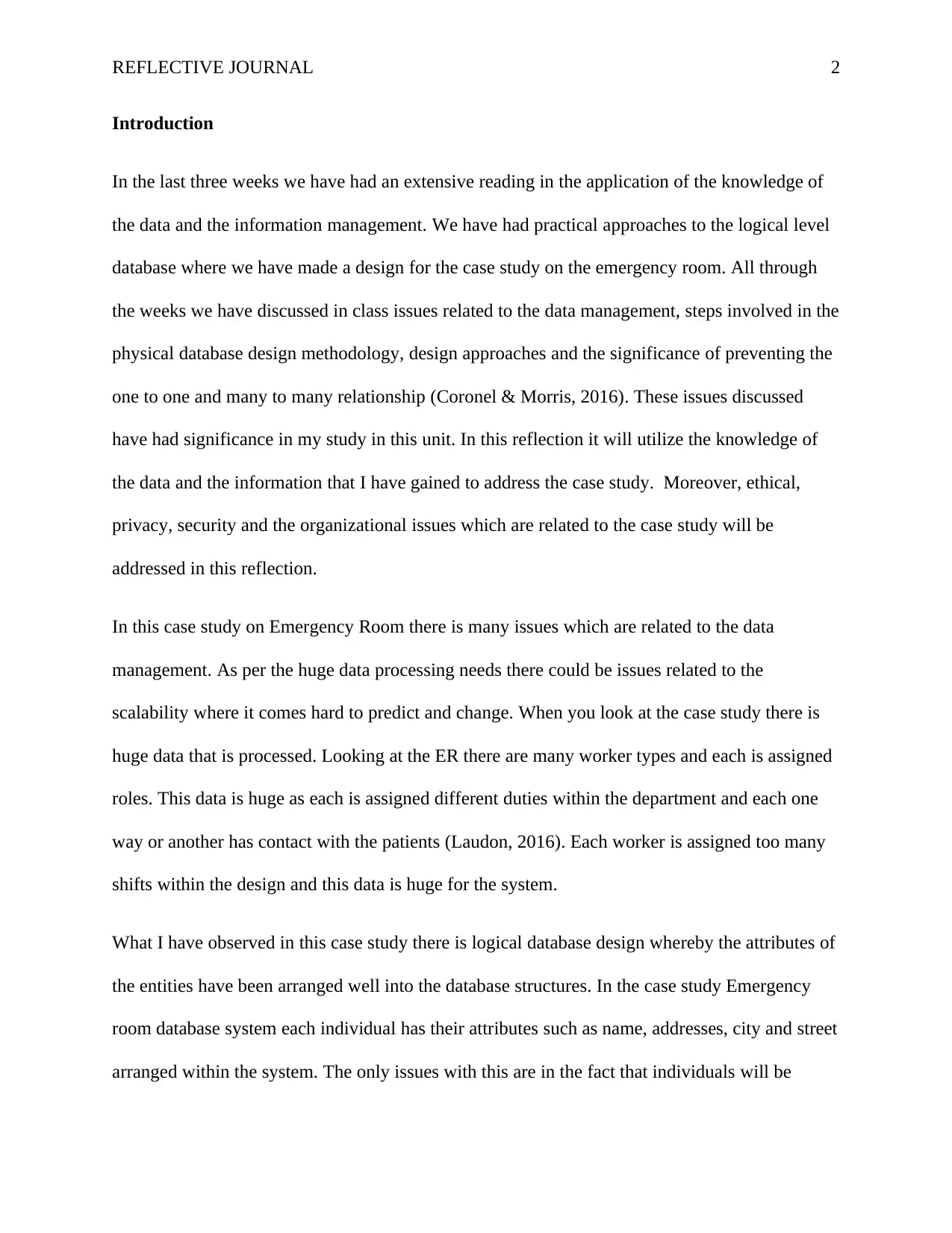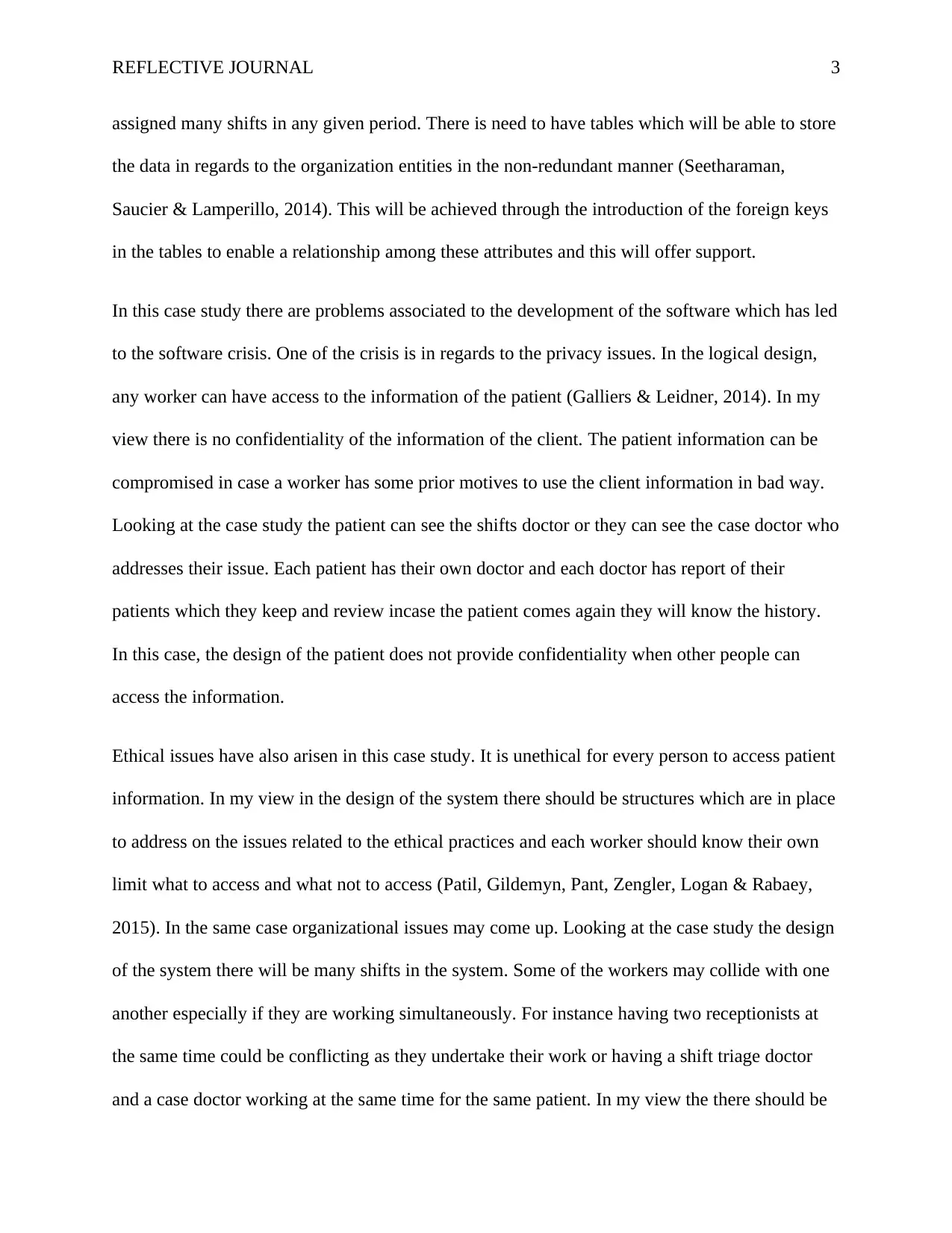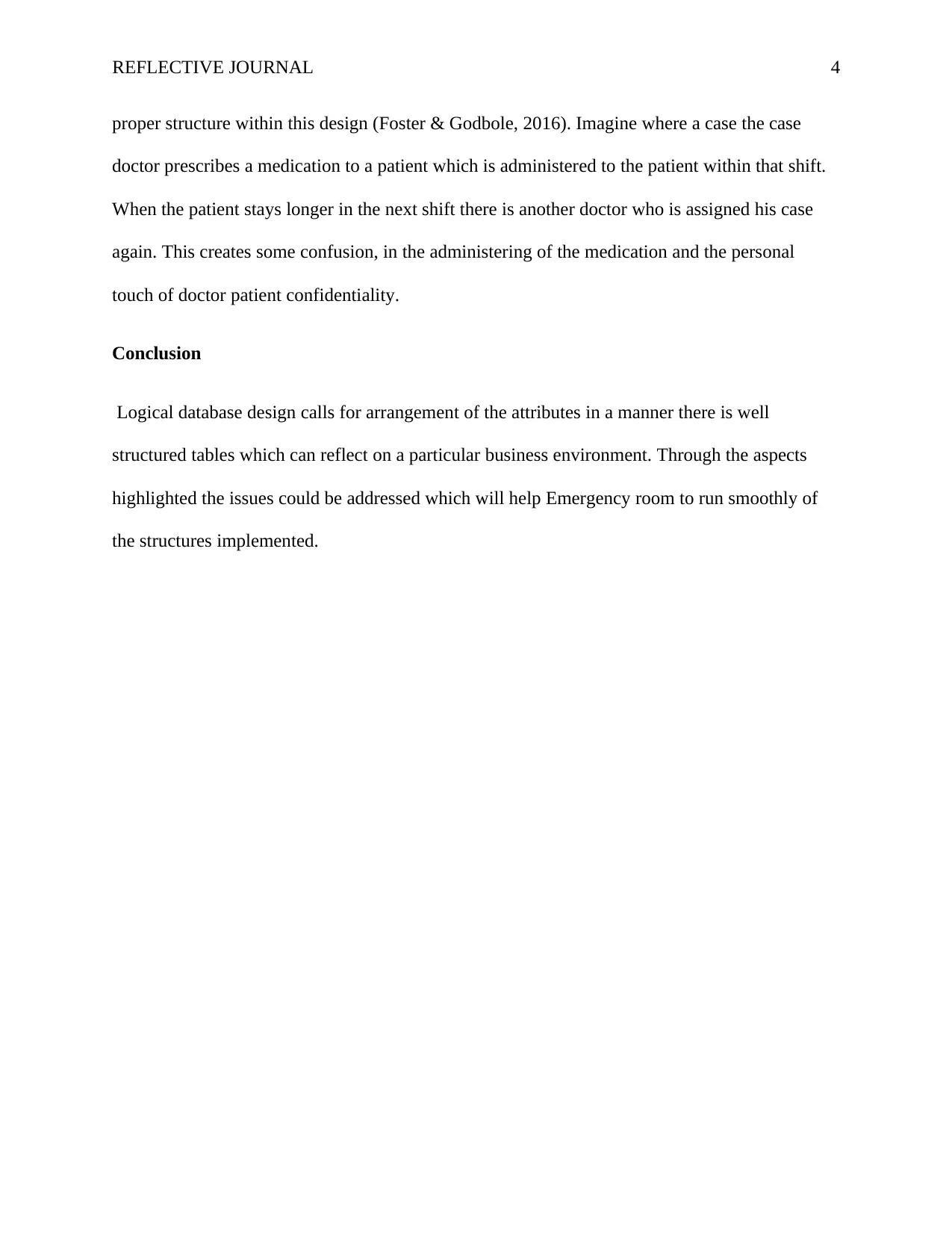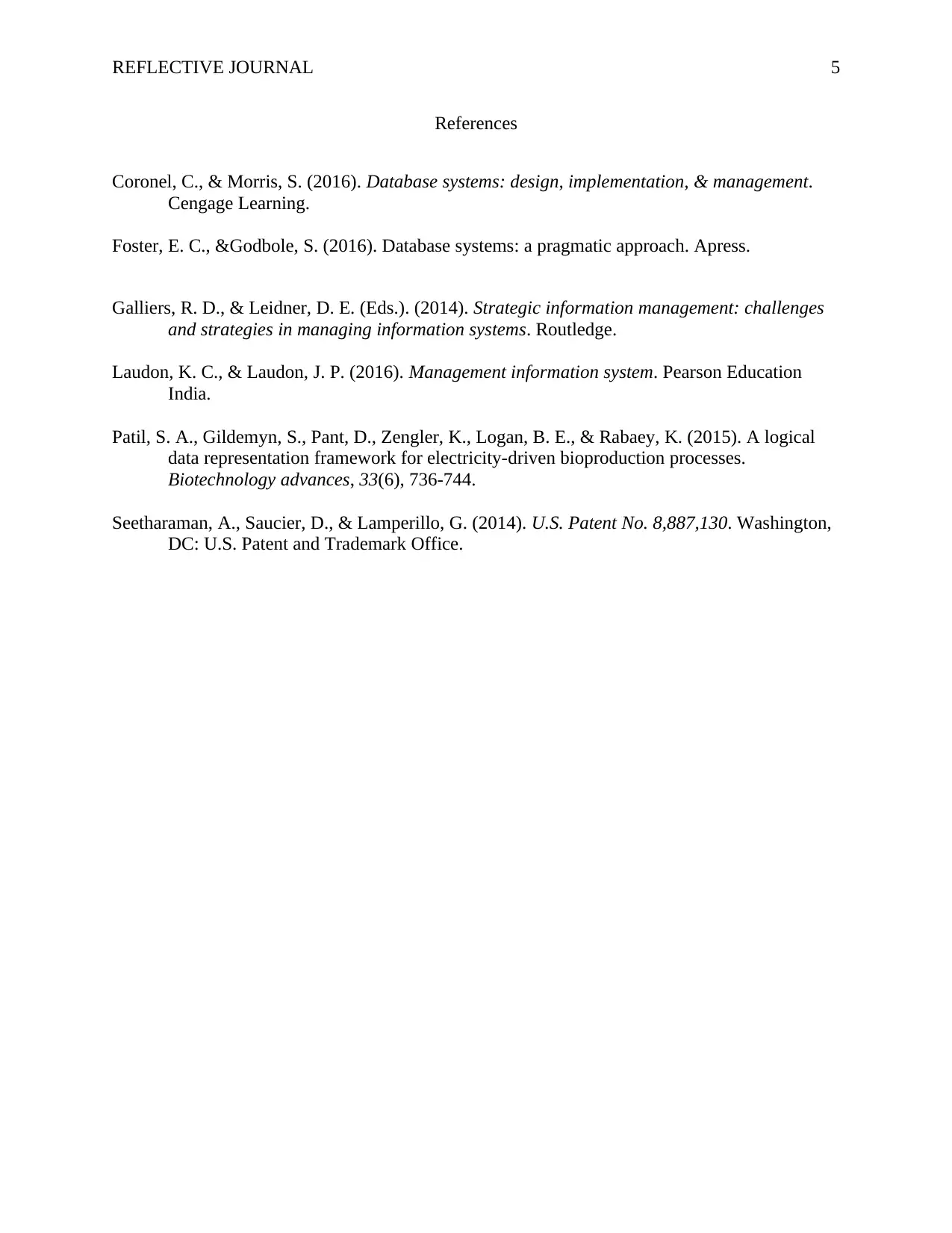Reflective Journal 1: Data and Information Management in Healthcare
VerifiedAdded on 2021/06/18
|5
|1080
|1462
Journal and Reflective Writing
AI Summary
This reflective journal analyzes data and information management concepts within the context of an emergency room case study. The student reflects on the application of data and information management knowledge gained over three weeks, including database design at the logical level, and discusses the significance of data relationships. The journal addresses scalability issues related to large datasets, worker roles, and shift assignments within the ER. Furthermore, it examines the logical database design, focusing on attributes and the need for foreign keys to manage relationships. The student identifies privacy, ethical, and organizational issues, such as worker access to patient information, confidentiality concerns, and potential conflicts in worker shifts, proposing solutions to improve the ER's data management practices and ensure smooth operations.

REFLECTIVE JOURNAL 1
Reflective Journal
Name:
Institution Affiliation:
Reflective Journal
Name:
Institution Affiliation:
Paraphrase This Document
Need a fresh take? Get an instant paraphrase of this document with our AI Paraphraser

REFLECTIVE JOURNAL 2
Introduction
In the last three weeks we have had an extensive reading in the application of the knowledge of
the data and the information management. We have had practical approaches to the logical level
database where we have made a design for the case study on the emergency room. All through
the weeks we have discussed in class issues related to the data management, steps involved in the
physical database design methodology, design approaches and the significance of preventing the
one to one and many to many relationship (Coronel & Morris, 2016). These issues discussed
have had significance in my study in this unit. In this reflection it will utilize the knowledge of
the data and the information that I have gained to address the case study. Moreover, ethical,
privacy, security and the organizational issues which are related to the case study will be
addressed in this reflection.
In this case study on Emergency Room there is many issues which are related to the data
management. As per the huge data processing needs there could be issues related to the
scalability where it comes hard to predict and change. When you look at the case study there is
huge data that is processed. Looking at the ER there are many worker types and each is assigned
roles. This data is huge as each is assigned different duties within the department and each one
way or another has contact with the patients (Laudon, 2016). Each worker is assigned too many
shifts within the design and this data is huge for the system.
What I have observed in this case study there is logical database design whereby the attributes of
the entities have been arranged well into the database structures. In the case study Emergency
room database system each individual has their attributes such as name, addresses, city and street
arranged within the system. The only issues with this are in the fact that individuals will be
Introduction
In the last three weeks we have had an extensive reading in the application of the knowledge of
the data and the information management. We have had practical approaches to the logical level
database where we have made a design for the case study on the emergency room. All through
the weeks we have discussed in class issues related to the data management, steps involved in the
physical database design methodology, design approaches and the significance of preventing the
one to one and many to many relationship (Coronel & Morris, 2016). These issues discussed
have had significance in my study in this unit. In this reflection it will utilize the knowledge of
the data and the information that I have gained to address the case study. Moreover, ethical,
privacy, security and the organizational issues which are related to the case study will be
addressed in this reflection.
In this case study on Emergency Room there is many issues which are related to the data
management. As per the huge data processing needs there could be issues related to the
scalability where it comes hard to predict and change. When you look at the case study there is
huge data that is processed. Looking at the ER there are many worker types and each is assigned
roles. This data is huge as each is assigned different duties within the department and each one
way or another has contact with the patients (Laudon, 2016). Each worker is assigned too many
shifts within the design and this data is huge for the system.
What I have observed in this case study there is logical database design whereby the attributes of
the entities have been arranged well into the database structures. In the case study Emergency
room database system each individual has their attributes such as name, addresses, city and street
arranged within the system. The only issues with this are in the fact that individuals will be

REFLECTIVE JOURNAL 3
assigned many shifts in any given period. There is need to have tables which will be able to store
the data in regards to the organization entities in the non-redundant manner (Seetharaman,
Saucier & Lamperillo, 2014). This will be achieved through the introduction of the foreign keys
in the tables to enable a relationship among these attributes and this will offer support.
In this case study there are problems associated to the development of the software which has led
to the software crisis. One of the crisis is in regards to the privacy issues. In the logical design,
any worker can have access to the information of the patient (Galliers & Leidner, 2014). In my
view there is no confidentiality of the information of the client. The patient information can be
compromised in case a worker has some prior motives to use the client information in bad way.
Looking at the case study the patient can see the shifts doctor or they can see the case doctor who
addresses their issue. Each patient has their own doctor and each doctor has report of their
patients which they keep and review incase the patient comes again they will know the history.
In this case, the design of the patient does not provide confidentiality when other people can
access the information.
Ethical issues have also arisen in this case study. It is unethical for every person to access patient
information. In my view in the design of the system there should be structures which are in place
to address on the issues related to the ethical practices and each worker should know their own
limit what to access and what not to access (Patil, Gildemyn, Pant, Zengler, Logan & Rabaey,
2015). In the same case organizational issues may come up. Looking at the case study the design
of the system there will be many shifts in the system. Some of the workers may collide with one
another especially if they are working simultaneously. For instance having two receptionists at
the same time could be conflicting as they undertake their work or having a shift triage doctor
and a case doctor working at the same time for the same patient. In my view the there should be
assigned many shifts in any given period. There is need to have tables which will be able to store
the data in regards to the organization entities in the non-redundant manner (Seetharaman,
Saucier & Lamperillo, 2014). This will be achieved through the introduction of the foreign keys
in the tables to enable a relationship among these attributes and this will offer support.
In this case study there are problems associated to the development of the software which has led
to the software crisis. One of the crisis is in regards to the privacy issues. In the logical design,
any worker can have access to the information of the patient (Galliers & Leidner, 2014). In my
view there is no confidentiality of the information of the client. The patient information can be
compromised in case a worker has some prior motives to use the client information in bad way.
Looking at the case study the patient can see the shifts doctor or they can see the case doctor who
addresses their issue. Each patient has their own doctor and each doctor has report of their
patients which they keep and review incase the patient comes again they will know the history.
In this case, the design of the patient does not provide confidentiality when other people can
access the information.
Ethical issues have also arisen in this case study. It is unethical for every person to access patient
information. In my view in the design of the system there should be structures which are in place
to address on the issues related to the ethical practices and each worker should know their own
limit what to access and what not to access (Patil, Gildemyn, Pant, Zengler, Logan & Rabaey,
2015). In the same case organizational issues may come up. Looking at the case study the design
of the system there will be many shifts in the system. Some of the workers may collide with one
another especially if they are working simultaneously. For instance having two receptionists at
the same time could be conflicting as they undertake their work or having a shift triage doctor
and a case doctor working at the same time for the same patient. In my view the there should be
⊘ This is a preview!⊘
Do you want full access?
Subscribe today to unlock all pages.

Trusted by 1+ million students worldwide

REFLECTIVE JOURNAL 4
proper structure within this design (Foster & Godbole, 2016). Imagine where a case the case
doctor prescribes a medication to a patient which is administered to the patient within that shift.
When the patient stays longer in the next shift there is another doctor who is assigned his case
again. This creates some confusion, in the administering of the medication and the personal
touch of doctor patient confidentiality.
Conclusion
Logical database design calls for arrangement of the attributes in a manner there is well
structured tables which can reflect on a particular business environment. Through the aspects
highlighted the issues could be addressed which will help Emergency room to run smoothly of
the structures implemented.
proper structure within this design (Foster & Godbole, 2016). Imagine where a case the case
doctor prescribes a medication to a patient which is administered to the patient within that shift.
When the patient stays longer in the next shift there is another doctor who is assigned his case
again. This creates some confusion, in the administering of the medication and the personal
touch of doctor patient confidentiality.
Conclusion
Logical database design calls for arrangement of the attributes in a manner there is well
structured tables which can reflect on a particular business environment. Through the aspects
highlighted the issues could be addressed which will help Emergency room to run smoothly of
the structures implemented.
Paraphrase This Document
Need a fresh take? Get an instant paraphrase of this document with our AI Paraphraser

REFLECTIVE JOURNAL 5
References
Coronel, C., & Morris, S. (2016). Database systems: design, implementation, & management.
Cengage Learning.
Foster, E. C., &Godbole, S. (2016). Database systems: a pragmatic approach. Apress.
Galliers, R. D., & Leidner, D. E. (Eds.). (2014). Strategic information management: challenges
and strategies in managing information systems. Routledge.
Laudon, K. C., & Laudon, J. P. (2016). Management information system. Pearson Education
India.
Patil, S. A., Gildemyn, S., Pant, D., Zengler, K., Logan, B. E., & Rabaey, K. (2015). A logical
data representation framework for electricity-driven bioproduction processes.
Biotechnology advances, 33(6), 736-744.
Seetharaman, A., Saucier, D., & Lamperillo, G. (2014). U.S. Patent No. 8,887,130. Washington,
DC: U.S. Patent and Trademark Office.
References
Coronel, C., & Morris, S. (2016). Database systems: design, implementation, & management.
Cengage Learning.
Foster, E. C., &Godbole, S. (2016). Database systems: a pragmatic approach. Apress.
Galliers, R. D., & Leidner, D. E. (Eds.). (2014). Strategic information management: challenges
and strategies in managing information systems. Routledge.
Laudon, K. C., & Laudon, J. P. (2016). Management information system. Pearson Education
India.
Patil, S. A., Gildemyn, S., Pant, D., Zengler, K., Logan, B. E., & Rabaey, K. (2015). A logical
data representation framework for electricity-driven bioproduction processes.
Biotechnology advances, 33(6), 736-744.
Seetharaman, A., Saucier, D., & Lamperillo, G. (2014). U.S. Patent No. 8,887,130. Washington,
DC: U.S. Patent and Trademark Office.
1 out of 5
Related Documents
Your All-in-One AI-Powered Toolkit for Academic Success.
+13062052269
info@desklib.com
Available 24*7 on WhatsApp / Email
![[object Object]](/_next/static/media/star-bottom.7253800d.svg)
Unlock your academic potential
Copyright © 2020–2025 A2Z Services. All Rights Reserved. Developed and managed by ZUCOL.





